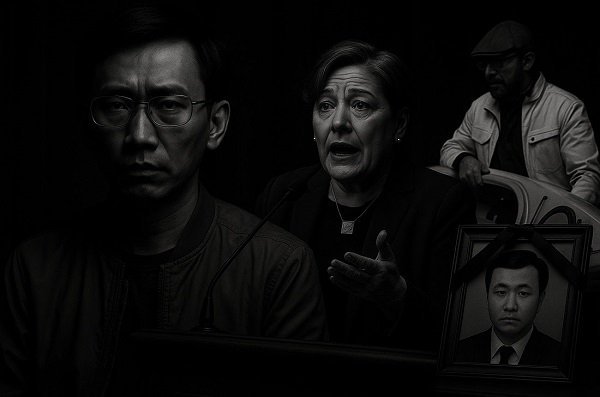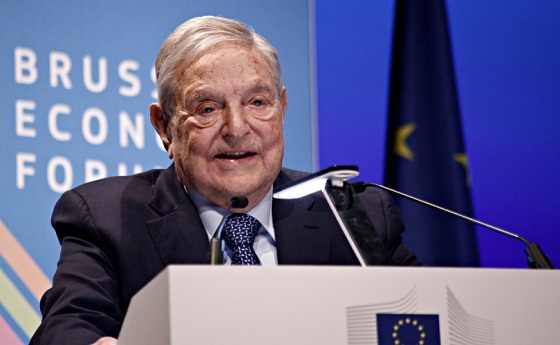espionage
BREAKING — Diaspora Coalition Urges Canadian Foreign Minister to Sanction Hong Kong Security Chiefs for Illegal Bounties on Canadians

CCP targets include 2025 Conservative election candidate Joseph Tay and former Chinese-language media editor Victor Ho, both named in HK$1 million bounties issued by Hong Kong police.
In the August 8 letter the groups invoke Canada’s Justice for Victims of Corrupt Foreign Officials Act (Sergei Magnitsky Law) and the Special Economic Measures Act, calling for asset freezes and travel bans on a roster of Hong Kong political, judicial, and security officials. These individuals, the letter says, have “played critical roles in enforcing the region’s repressive policies, undermining judicial independence, and facilitating the persecution of pro-democracy activists.”
The push echoes pressure from several of the same groups to escalate the case of one Canadian bounty target — Tay. According to Canadian intelligence assessments, Tay was targeted by Chinese state security in a campaign allegedly amplified by his Liberal rival, MP Paul Chiang. In the aftermath, Tay’s relatives in Hong Kong were detained and questioned by police. Hong Kong authorities have since expanded their wanted list to include additional overseas activists.
The letter to Anand singles out officials most directly responsible for the December 2024 charges amplified by Paul Chiang — among them Chris Tang Ping-keung (Secretary for Security), who invoked Hong Kong’s Article 23 “Safeguarding National Security Ordinance” to impose special orders against former lawmakers and activists; and Raymond Siu Chak-yee (former Commissioner of Police), who led the Hong Kong Police in posting HK$1 million bounties for information leading to the arrests of dozens of overseas activists, including Canadian citizens Tay and former Sing Tao Daily editor Victor Ho.
Victor Ho’s assertion that the Chinese Communist Party has effectively taken control of all Chinese-language media in Canada is reflected in a 2022 CSIS document on Chinese election interference obtained by The Bureau. “The CCP weaponizes the Chinese media to gain election intervention,” Ho told The Bureau in a 2023 story on that document. “To do this, the Chinese Consulates in Canada make every effort to influence the top Chinese editing teams in Canada.”
Hong Kong authorities have issued international arrest warrants and cash rewards — ranging from HK$200,000 to HK$1 million (C$35,000 to C$175,000) — for six pro-democracy activists with ties to Canada, including three Canadian citizens.
In the August 8 letter to Anand, Edmund Leung, chair of the Vancouver Society in Support of Democratic Movement, says: “The actions of these officials constitute a direct attack on the principles of democracy, human rights, and the rule of law.”
“By targeting specific individuals who have misused their authority to oppress rather than uphold the integrity of the judiciary, Canada will send a clear message that judicial positions are not shields for impunity,” the letter says.
Cheuk Kwan, co-chair of the Toronto Association for Democracy in China, added: “We count on Canada to continue its leadership role post-G7 summit. By imposing these sanctions, Canada will send a strong message to the world that it stands firmly against human rights abuses and authoritarian overreach.”
His appeal carries particular weight: Kwan played a central role in exposing one of the most explosive diaspora interference cases in recent Canadian politics. As The Bureau reported in March, he helped publicize evidence that Chiang had amplified an illegal Hong Kong bounty targeting Tay — evidence the RCMP confirmed they were reviewing, but only after Hong Kong democracy groups intensified pressure on Ottawa.
The safety threats linked to that bounty effectively shut down Tay’s in-person campaign in Don Valley North. Despite calls for intervention, then–Liberal leader Mark Carney refused to remove Chiang from the race. Chiang stepped aside only after the RCMP announced its review — and the Liberals went on to hold the seat.
The new sanctions request names senior Hong Kong officials alleged to have orchestrated and enforced these transnational repression measures, including:
- Paul Lam Ting-kwok, Secretary for Justice, who in 2022 ordered 47 pro-democracy activists tried without a jury, breaking Hong Kong’s 177-year tradition of jury trials.
- Chris Tang Ping-keung, Secretary for Security, who in 2024 invoked Article 23 to cancel passports, freeze assets, and block financial transactions for exiled activists.
- Raymond Siu Chak-yee and Joe Chow Yat-ming, current and former Police Commissioners, who authorized HK$1 million bounties against overseas activists, including Tay and Ho.
- Andrew Kan Kai-yan and Steve Li Kwai-wah, National Security Department officers accused of freezing activists’ bank accounts and criminalizing financial support.
- John Lee Ka-chiu, Chief Executive, whose administration advanced Article 23 legislation and intensified mass arrests under the National Security Law.
The signatories argue these actions breach international law, including the Universal Declaration of Human Rights, and meet the threshold for Magnitsky and SEMA sanctions.
Magnitsky sanctions stem from the case of Russian lawyer Sergei Magnitsky, who died in a Moscow prison in 2009 after exposing a massive state-backed tax fraud scheme. Canada’s version allows Ottawa to freeze assets and ban travel for foreign officials involved in human rights abuses or significant corruption.
espionage
Digital messages reportedly allege Chinese police targeted dissident who died suspiciously near Vancouver

 Sam Cooper
Sam Cooper
‘Our superiors … want to get rid of him’
Radio-Canada, drawing on digital records first disclosed to Australian media in 2024 by an alleged Chinese spy, has reported new evidence suggesting that a Chinese dissident who died in a mysterious kayaking accident near Vancouver was being targeted for elimination by Chinese secret police and agents embedded in a Chinese conglomerate that the U.S. Treasury now accuses of running a multibillion-dollar organized-crime, money-laundering and modern-slavery empire out of Cambodia.
The new reporting focuses on a man identified only as “Eric,” a former undercover agent for Office No. 1 of China’s Ministry of Public Security — the police ministry at the core of so-called “CCP police stations” in global and Canadian cities, and reportedly tasked with hunting dissidents abroad.
Australia’s Four Corners revealed Eric’s story in May 2024, reporting that he had fled China in 2023 and walked into the headquarters of Australia’s domestic intelligence agency, ASIO, carrying a phone loaded with years of internal messages and records.
It also reported that Eric had been invited to testify in Canada’s Foreign Interference Commission, known as the Hogue Commission, about Beijing’s operations on Canadian soil.
“In an August 2024 report, ABC Investigations wrote: ‘Eric told ABC Investigations he had been invited to testify as a witness in the next round of hearings, scheduled to start in September.’”
But there is no public sign that his evidence was ever examined in open hearings or mentioned in the Commission’s final reports, suggesting that any material he supplied was handled entirely behind closed doors, if at all.
According to Radio-Canada’s Enquête program, reporters travelled to Australia to interview Eric and forensically review the contents of his phone: thousands of text and voice messages between 2016 and 2023, as well as financial records and internal documents that he says came from Office No. 1 and its corporate covers.
The archives reportedly include detailed exchanges with his superiors, evidence of clandestine money transfers and the names of individuals allegedly involved in overseas espionage and repression.
One sequence, labelled “The target,” captures the moment Eric is ordered to focus on a dissident painter named Hua Yong, who had already become notorious in China for blood-marked Tiananmen commemorations and for documenting mass evictions in Beijing.
Citing the exchange, which has not been independently reviewed by The Bureau, Radio-Canada quotes:
Office No. 1: Our future communications must be encrypted.
Eric: What are the orders?
Office No. 1: Listen carefully to my request. It concerns Hua Yong. Our superiors find him troublesome and want to get rid of him.
Those messages set the tone for what follows: a multi-year manhunt that begins in Thailand and ends with Hua dead off Canada’s Sunshine Coast. Eric says Hua was formally designated a high-value target, and the same phone records, as summarized by Enquête and earlier Four Corners reporting, show that a bounty was placed on Hua’s head — roughly the equivalent of US$20,000 if he were captured and repatriated.
To win Hua’s trust, Eric reportedly constructed an elaborate false persona. On social media and encrypted apps, he posed as a radical anti-Communist militant, proposing the creation of a jungle “armed camp” and a band of revolutionaries. He then invented “Brigade V,” a fake guerrilla group he promoted online while appearing in videos in camouflage and a balaclava. Hua, in exile and under pressure, was impressed. “This is brilliant,” he reportedly wrote privately, according to the message logs, and the two men soon met in person in Bangkok, drinking wine and plotting what Hua believed was resistance — all while Eric quietly fed reports back to the political-security police.
The Bureau is a reader-supported publication.
To receive new posts and support my work, consider becoming a free or paid subscriber.
It is this kind of mix of covert state targeting and deniable intermediaries that is now worrying Western security officials.
In November, ASIO director-general Mike Burgess used a major speech to warn that some authoritarian regimes are showing a “growing willingness” to mount “high-harm operations” abroad. Without naming specific countries, and not referring to Eric’s alleged evidence, he said his service believes “at least three nations” are willing and capable of carrying out lethal attacks in Australia, and may try to hide their involvement by contracting criminal “cut-outs.”
Canada’s own oversight bodies have been tracking a similar threat pattern.
In a 2024 report, the National Security and Intelligence Committee of Parliamentarians (NSICOP) described a fully redacted 12-paragraph case study of what it called the “most egregious” People’s Republic of China proxy identified by Canadian intelligence. The public summary says CSIS assessed that one aspect of the proxy’s behaviour posed a “high-risk, high-harm” threat to some Canadians and permanent residents, and that CSIS shared information on the proxy with the RCMP.
The same report notes that intelligence from CSIS and the Communications Security Establishment showed foreign states covertly attempting to buy influence with candidates and elected officials — a backdrop that makes the Hua Yong file, and the allegations of lethal targeting orders and corporate covers around Eric, especially sensitive.
Eric’s phone records, as described by Enquête, show that companies tied to his work gave him the freedom and cover to travel across Southeast Asia, build false identities and infiltrate exile networks, while maintaining his status as an MPS officer. One cover in particular stands out: a vast conglomerate in Cambodia that, on paper, dealt in real estate and finance and handled billions of dollars. Enquête identifies it as Prince Group and says Eric worked under its umbrella in 2016–2017 — a claim the company reportedly did not answer when approached by Radio-Canada.
That corporate name now has much wider resonance, and alleged connectivity to China’s United Front Work Department.
In October, the U.S. Justice Department unsealed an indictment charging Prince Group chairman Chen Zhi with orchestrating a forced-labour “pig-butchering” scam empire from compounds in Cambodia, while the U.S. Treasury and its U.K. counterpart simultaneously designated the “Prince Group Transnational Criminal Organization,” sanctioning Chen and 146 linked individuals and entities. Officials allege the network ran industrial-scale cyber-fraud centres staffed by trafficked workers, laundered billions in criminal proceeds and used shell companies and high-end real estate — including London properties — to wash illicit funds.
U.S. material also ties Prince Group into the orbit of Chinese state-aligned figures. Sanctions filings link Chen Zhi to Wan Kuok-koi, the Macau Triad boss known as “Broken Tooth,” whose modern Hongmen association has been described by U.S. officials as directly connected to the Chinese Communist Party’s United Front Work Department. They further allege that Prince Group worked with Palau-based businesswoman Rose Wang, a former vice-president of Palau’s Overseas Chinese Federation, who helped broker access and casino licences while acting as a facilitator for the scam network — a role analysts say dovetails with informal diplomacy and influence work on Beijing’s behalf.
Against that background, Eric’s description of Prince Group as one of his covers fits with The Bureau’s source material tying alleged Chinese police-station networks in Canada to underground casino and Chinese mafia structures entangled with United Front-aligned political figures.
In Eric’s interview with Radio-Canada, he portrays the Prince Group conglomerate as part of a broader ecosystem of ostensibly legitimate companies that quietly cooperate with Chinese security services — providing salaries, visas, office space and a glossy façade for officers like him to operate overseas. The digital trail Enquête reconstructed links that ecosystem to the micro-level surveillance of Hua Yong: reports on his movements, photographs of his residence in Canada, and continual updates to superiors who had bluntly said they wanted to “get rid of him.”
By April 2021, Hua had slipped out of Southeast Asia and arrived in Halifax on a humanitarian protection visa. From there, he moved west, eventually settling in the coastal community of Gibsons, British Columbia. Enquête reports that Eric continued to track him remotely, sending situation reports back to Office No. 1 even after Hua appeared to have found a measure of safety in Canada.
In November 2022, Hua reportedly set out alone in a bright yellow kayak and never returned. His body was later found on an island off the Sunshine Coast. The RCMP concluded that he had drowned and said they found no evidence of foul play; officers were not aware, at the time, that he was the subject of a Chinese police operation. According to Radio-Canada, three years later the case is still not fully closed: the British Columbia coroner has yet to issue a final report — an unusually long delay in a province where such inquests typically take around 16 months. In an email cited by Enquête, the Coroners Service said factors such as the complexity of a file and “investigations conducted by other agencies” can prolong a case.
According to Radio-Canada, Eric himself is ambivalent about what happened on the water that day. He told Enquête he had wondered whether Hua was murdered and recalled Hua’s own suspicion, during a severe illness in Canada, that he might have been poisoned. But he also pointed to later online information suggesting the death might have been an accident, and emphasized that he has no definitive proof either way. What he does insist on is that Hua was a live target of a Chinese operation at the time he died — and that, based on standard MPS tradecraft, there were “certainly other teams” beyond him monitoring the dissident in Canada.
Eric also reportedly says he has never been contacted by RCMP about Hua’s death. Instead, he told Enquête that he has provided documents from his phone archive to Canada’s Commission of Inquiry into Foreign Interference in confidential channels. From his vantage point — as the officer who received the “get rid of him” order, posed as Hua’s ally and then watched him restart his life in Canada — he argues there are “strange aspects” to the case that demand further scrutiny.
The Bureau is a reader-supported publication.
To receive new posts and support my work, consider becoming a free or paid subscriber.
espionage
Soros family has been working with State Department for 50 years, WikiLeaks shows

From LifeSiteNews
Files from State Department officials as early as the 1970s show the US government helping the family of radical leftist financier George Soros secure deals and funding.
The U.S. State Department has been working with the Soros family for at least 50 years, Mike Benz demonstrated using diplomatic cables published to Wikileaks.
Benz, a former deputy assistant secretary at the U.S. State Department, explained in a video posted to X on Sunday that he searched for the terms “Soros” and “Open Society Foundation,” which was created by Soros, in Wikileaks’ collection of diplomatic cables. His goal was to “create a comprehensive tapestry of all U.S. state department involvement with Soros and the Open Society Foundation in every country in the world.”
The former state department official, now the executive director of the Foundation for Freedom Online, wanted to document why it was said that George Soros is treated by the U.S. like an “independent entity” akin to a country.
In a 1995 piece published by The New Yorker, former U.S. Ambassador to Turkey Morton Abramowitz said of Soros, “he’s the only man in the US who has his own foreign policy — and can implement it.”
Strobe Tallbott, former deputy secretary of state, also said of the far-left financier, “It’s like working with a friendly, allied, independent entity, if not a government. We try to synchronize our approach to the former Communist countries with Germany, France, Great Britain — and with George Soros.” This he “added with a grin,” wrote Connie Bruck.
Benz reviewed key cables from State Department officials as far back as the 1970s demonstrating the U.S. government’s involvement with the Soros family in what appeared to be a quid pro quo relationship.
In one 1976 cable from former U.S. Secretary of State Henry Kissinger, it was shown that the Brown & Root (now Halliburton), a CIA-linked company known for work on military installations and off-shore drilling platforms, wanted to “go all out” for the construction of a port in Santa Clara, Gabon, a country on the west coast of Africa.
It is noteworthy that Brown & Root’s co-founder Herman Brown was granted a covert security clearance for work with the CIA in 1953 “for use as a covert associate.” As of the 2000s, the company was one of George Soros’ top five holdings, Benz showed.
Referencing Brown & Root’s Manager of International Sales, Kissinger wrote, “O’Sullivan has just come from detailed discussions with Soros Associates to develop background for on-site estimates of construction timetable and costs … to be used in forthcoming talks with Gabon officials.”
Soros Associates, Benz explained, was run by George Soros’ older brother Paul Soros, now deceased.
The cable, addressed to the U.S. Embassy in Gabon, seemed to pressure assistance for the construction of this port, noting that while the request for help with it came at a “difficult time,” “strong interest” in the project and other reasons “preclud[ed] deferral.”
Another series of messages show that the U.S. Department helped the Soros family to secure a contract for the port in Gabon.
According to one cable, the director of the Santa Clara port, named as “Damas,” “said that meetings had been held within the Government of Gabon and were continuing which should lead shortly to the elimination of all but a few offers and that Soros was in a very good position.”
Benz remarked, “Here is the head of the State Department in Gabon backchanneling with the head of the port to make sure that Paul Soros won the bid. Eliminate all of the opposition.”
Another message read, “It appears Soros Associates virtually certain to get engineering contract for Port.”
“Not only is the US State Department negotiating Soros’ deals, helping him secure the deals. They’re also backchanneling so that foreign governments can pay [S]oros so that Soros makes his appropriate profit on the deal,” remarked Benz.
“There is this favors-for-favors relationship that goes back five decades, And those are just the earliest cables we have,” he added.
The exposure of these cables has been described as an “ultra massive find” by journalist Alex Jones.
The find is massive because George Soros himself, as was admitted by Morton Abramowitz and Strobe Tallbott, has foreign policy interests independent of the U.S. and over the past decades has demonstrated influence on U.S. domestic policy in favor of an impotent justice system, internet censorship, and a wide range of left-wing causes such as abortion, euthanasia, and population control, as well as homosexual “marriage,” and transgenderism. In other words, as some commentators have put it, his impact has been to erode the moral fabric of America and weaken the country.
-

 Business2 days ago
Business2 days agoRecent price declines don’t solve Toronto’s housing affordability crisis
-

 MAiD19 hours ago
MAiD19 hours agoFrom Exception to Routine. Why Canada’s State-Assisted Suicide Regime Demands a Human-Rights Review
-

 MAiD2 days ago
MAiD2 days agoHealth Canada report finds euthanasia now accounts for over 5% of deaths nationwide
-

 Daily Caller2 days ago
Daily Caller2 days agoTech Mogul Gives $6 Billion To 25 Million Kids To Boost Trump Investment Accounts
-

 Automotive1 day ago
Automotive1 day agoPower Struggle: Governments start quietly backing away from EV mandates
-

 Energy2 days ago
Energy2 days agoUnceded is uncertain
-

 Business17 hours ago
Business17 hours agoCarney government should privatize airports—then open airline industry to competition
-

 Business1 day ago
Business1 day agoNew Chevy ad celebrates marriage, raising children






